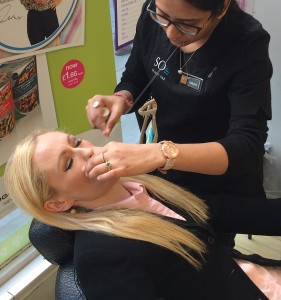One of my favourite websites is NHS Choices, the official site of the National Health Service. Few sites tell it like it is with such unashamed clarity. Medical terms are explained succinctly and plainly, without emotion or agenda. And it was my first point of reference when researching epilating, or hair removal.
Many women remove hair from their legs, bikini line, armpits and eyebrows, but “hirsutism” is excessive hair growth. It is caused by an excess of male sex hormones called androgens, or an increased sensitivity to them. This is mostly caused by polycystic ovaries though 10% of cases have no obvious causes.
This excess hair is usually thick and dark, and may affect around one in every 10 pre-menopausal women. After the menopause, hormonal changes mean up to 75% may have more facial hair. And hair on the upper lip can often look like the fine lines acquired through age or years of smoking, further adding to the effect of a premature dotage.
Excess hair may also grow on the chest, stomach, thighs, and around the genitals. It can also be associated with oily skin, acne, alopecia, a receding hairline, an enlarged clitoris and a deepening of the voice. Unsurprisingly, left untreated, all this can cause depression, embarrassment and lack of self-confidence.
There is no cure, though some women take the contraceptive pill to control it. And there are a number of hair-removal methods that may help, such as shaving, plucking, waxing, bleaching, removal creams and threading.
While all of them work, there are also drawbacks. Shaving can make a woman feel about as feminine as a dock worker, and can encourage the resprouting of bristles. The same goes for plucking, which can also stretch the skin.
Waxing means enduring unsightly regrowth until it reaches a treatable length, and bleaching facial hair can render some women just a horned helmet and blond plaits short of a Viking. Then there are the ingrown hairs, which can occur after all these treatments. And removal creams can be harsh for some skin types. So, on balance, I would opt for threading.
With its origins obscured in history, this ancient practice allegedly started over 6,000 years ago in India and spread throughout Asia, the Middle East, and then Europe. It is used to shape eyebrows, as well as removing all types of facial hair.
In threading, a thin cotton or polyester thread is rolled over areas of unwanted hair, plucking lines of it out at the follicle level. It is initially slightly painful and can make your eyes water, but this quickly subsides.
Like waxing, regrowth is often finer, though threading is more precise and seems gentler on the skin. It is usually cheaper too, and treatments take only a few minutes.
So, next time you walk past your local beauty shop window and catch sight of a slightly fluffy reflection, consider nipping in for just a few pounds and five minutes with the lady and the black chair. It’s worth a tear and a few minutes’ redness to take five years off your face – and put the confidence back in your step.



Comments are closed.